The Bunjum Saltwater Women Art Group describe this artwork as 'walking on saltwater Country' .
Along the Coastal Walk ...

This Country is where people have come to meet, connect, to yarn, tell stories, gather food, share meals and camp for as long as many of the Aboriginal community can remember.
Being on Country, sitting, listening, and respecting the environment can evoke a deeper appreciation of the interconnection of natural, aesthetic and cultural values of a place.
Take a moment to rest at this place to appreciate its beauty and its significance as a special gathering place.
You are invited to take a seat and listen to the stories that Elders and community members have chosen to share with you here.
Community on Country
“When I was a young fella my uncles talked about the fish traps around Ballina and Lennox Head. The old people said that these fish traps were very important to catch fish especially when there was a big gathering, and when the salmon run every year. We would spear the salmon in the surf at Angels Beach all along the coast. Mobs would come from out west and other tribes that surrounded us during these times of abundance to catch and eat the fish and oysters and small game in the bush.” Uncle Lewis Cook 2021
Uncle Lewis speaks more about connections to Country and of the significance of these places to the local community in recordings provided at signage nodes 1. East Ballina Gathering Place and 2. Landscape Regeneration.
In 2021, Aunty Millie had vivid memories of what it was like to visit here around Lennox Head as a child...
The isolated rocky outcrop marking the northern tip of Skennars Head (Whites Head) is a place we know today as Iron Peg. This reflects the original 1930s installation there of a belay peg fishermen could attach to while trying their luck at such an exposed and dangerous location.
Uncle Lewis recalls fishing at this spot.
“When I was a young man I often fished at Iron Peg known to our family as ‘Poison Snake Dreaming’, as I fished on the rocks a freak wave came and smashed against me as the water rose I dived towards the Iron Peg and hung on to save my life, the wave splashing over me. My old uncle told me that the freak wave was the poison snakes bite from the dreamtime story at this place.” Uncle Lewis Cook 2021
[N.B. The creation of the basalt coastal features of Iron Peg and Boulder Beach is told in an Aboriginal creation story describing a battle between a black snake and a goanna. This story is told at the Flat Rock Lookout node along the Coastal Recreational Path. The story recounts how the rocks in the surf line at Boulder Beach are the goanna’s eggs. These were found by the black snake who decided to lie in ambush to await the goanna’s return. The shape of the snake can be discerned today within the feature of Iron Peg. Its bite are the fierce waves that can snatch people off this exposed rock outcrop.]
Aunty Millie also recalls fishing when she was younger and cooking them up.
Cabbage Tree Island Memories
Aboriginal people have had a connection to Cabbage Tree Island near Wardell in the south of the Ballina Shire for a very long time. Cabbage Tree Island has become a place of great importance and value to the local cultural identity.
Memories about this place and the local area (including the river that surrounds the Island, the beach at Boundary Creek and nearby Broadwater) are highly valued and are reflected in the stories and recollections they share with you here.
Aunty Julia Paden remembers catching prawns for her friend Ponny’s family to fish with and getting a nasty sting by a bullrout.
[A bullrout is a well camouflaged fish found in upper tidal reaches and freshwaters of New South Wales and Queensland armed with sharp, strong dorsal spines that readily penetrate the feet or hands of unwary swimmers and cause excruciating pain.]
Aunty Julia tells a story about having to swim to Cabbage Tree Island, because she couldn’t get a boat to pick her up.
Cutout panel artwork credits

Metal panel artwork credits: Digby Moran, Lois Cook




